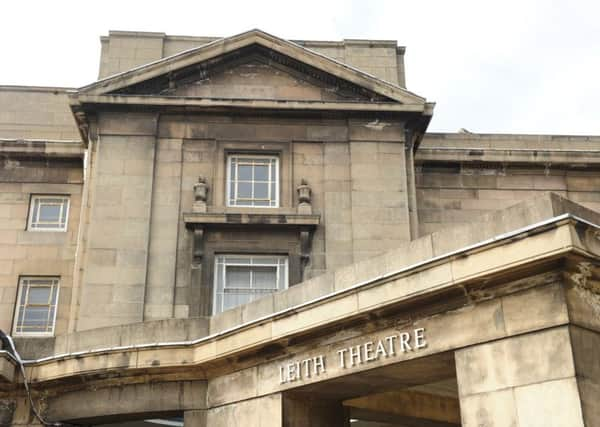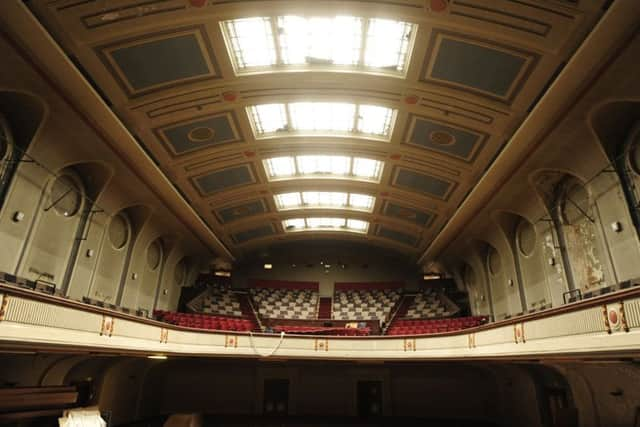Trainspotting author plots Leith's return to the stage


Yet oddly – although huge numbers of young Edinburgh-based artists and performers live in or around the area – the old port of Leith has for years been absolutely bereft of large and medium-sized entertainment venues, almost entirely uninvolved in the Edinburgh Fringe, and completely without a local theatre or independent cinema of its own.
Which is why it makes every kind of sense that a groundswell of grassroots feeling – now backed by Irvine Welsh, and a formidable community group – seems on the verge of bringing back to life the impressive building at the corner of Great Junction Street and Ferry Road now known as Leith Theatre, although it was built in 1932 as Leith Town Hall and Library. Built in a gracious neo-classical style with touches of art deco, and designed by Bradshaw, Glass & Hope architects from Bolton, the building was conceived as a groundbreaking cultural and civic centre, with a grand main concert hall seating 1,500 people, a comfortable Lesser Hall now known as the Thomas Morton Hall, bars, reception rooms, a wedding suite, and of course the fine semi-circular library, still in operation.
Advertisement
Hide AdAdvertisement
Hide AdThe building opened in grand style on 20 July 1932, but in 1941 it was seriously damaged by a bomb aimed at Leith Docks, and did not reopen until 1960.


For the next 25 years, it thrived as a venue for civic events, for major concerts featuring bands including AC/DC and Kraftwerk, for amateur musicals and light opera, and for Edinburgh International Festival productions; I had one of my own formative experiences as a theatre critic there, in February 1981, watching a production of The Pirates Of Penzance on the night of the engagement of Prince Charles and Diana Spencer. In 1988, though, Edinburgh City Council– which owns the building – decided to close it down; and after years of neglect, a 2004 City Council theatres review recommended selling the site off for redevelopment.
It was at this point, though, that a community-based group stepped in to try to save the building; and last January, after more than a decade of campaigning, and of complex negotiations with the council, the Leith Theatre Trust finally took control of the building. In the last year, the city council has met its obligations under the lease by completing the weather-proofing of the building and repairing the external glass roof-lights of the main hall; meanwhile, the Trust – chaired by musician, civic campaigner and former town planner Jack Hunter – has been working to boost the venue’s income from functions, events and music sessions in the Thomas Morton Hall, and from the venue’s still-operational wedding suite.
And now, pressure is building to restore the dilapidated main auditorium to the point where it can once again become a major music venue in a city which, over the last few years, has lost many much-loved mid-scale spaces, including the Picture House on Lothian Road. In May, Leith Theatre will welcome Edinburgh’s hugely inventive Hidden Door festival, which will explore the derelict and less-derelict spaces of the building with its usual fearless flair; and this week it was announced that Irvine Welsh – author of Trainspotting, and a Leither by birth – has become Leith Theatre’s patron, and will lead an initial appeal for £250,000 to redecorate and refurbish the main auditorium for regular use, as well as a longer term appeal for around £10 million to complete the full restoration of the building.
Advertisement
Hide AdAdvertisement
Hide Ad“There’s certainly not much public money around at the moment,” says board member Mike Griffith, theatre producer and former executive director of the Traverse, as he and Hunter walk me round the theatre. “So it is going to be largely a community effort. We have some terrific assets, though. There’s a really powerful group of Edinburgh-based professionals offering free advice and expertise, on our board and beyond – architects, accountants, former cultural policy advisors, and so on.


“Then we’re building up relationships with Edinburgh College and other local educational institutions offering theatre courses, in the hope that their students will be able to play a part in bringing the building back to life. And we have an impressive group of volunteers – around 100, at maximum – who are willing to put in some work both in areas like front-of-house staffing, and on the fabric of the building. We’ve appointed a venue manager and assistant to run the venue in its present form; we’re building relationships with all the community groups who already use the Thomas Morton Hall. And we have ambitions eventually to run our own artistic programme, too; for example, our former artistic director, John Paul McGroarty, is hoping to stage a major event in November 2018 to mark the 100th anniversary of the Armistice, based on Karl Kraus’s The Last Days Of Mankind.”
No-one connected with Leith Theatre seems to be under any illusion about the difficulties that lie ahead in a cold funding climate. Yet as I sit on a battered plush seat in the main theatre balcony – roughly where I sat on that evening in 1981 – there’s an odd feeling of time slipping away, and the old building emerging essentially unscathed from years of dilapidation. “You know, it’s a bit battered,” says the Hunter, guiding us across the theatre’s beautiful, gently-raked parquet floor on our way out. “But it’s completely sound. And it feels like that, doesn’t it? Steel-framed, substantial – like a building that still has a huge amount to give to the people of Leith and Edinburgh, and is right here, waiting.” ■
The Hidden Door Festival 2017 is at Leith Theatre, from 26 May until 4 June, www.hiddendoorblog.org; www.leiththeatretrust.org